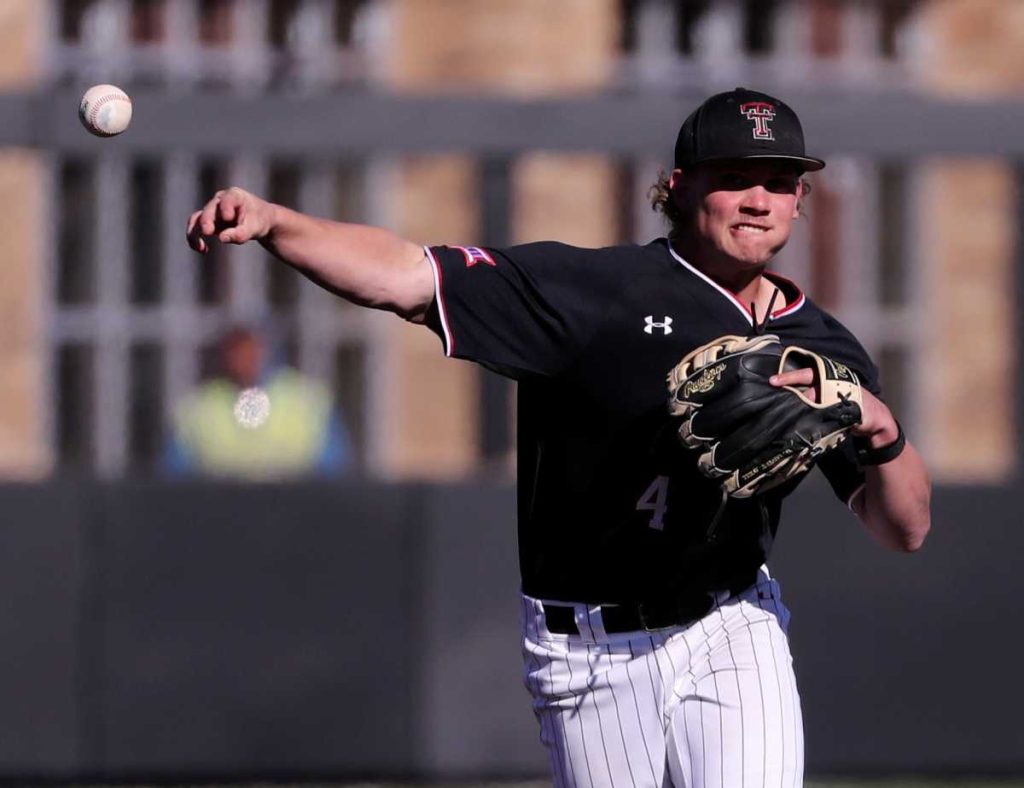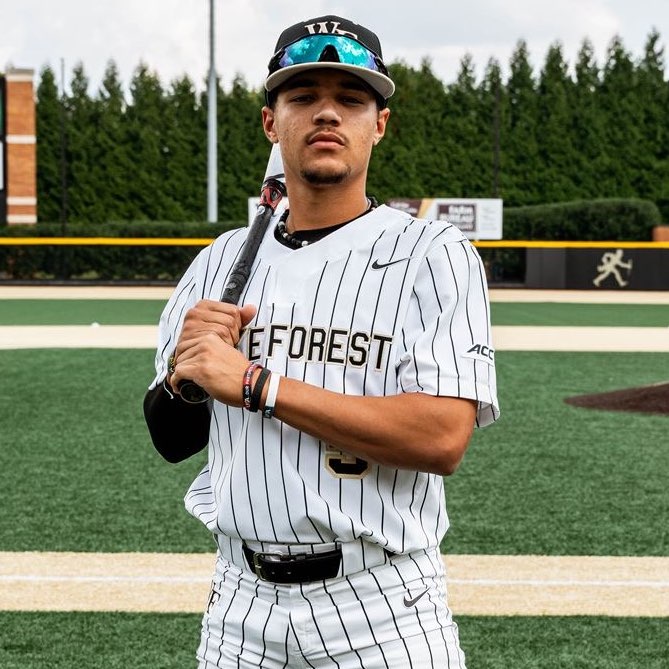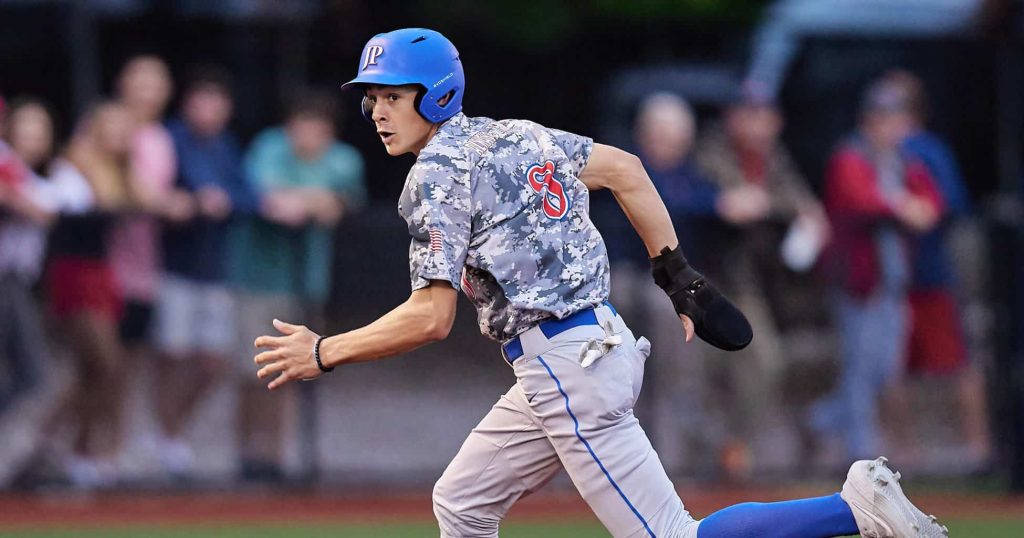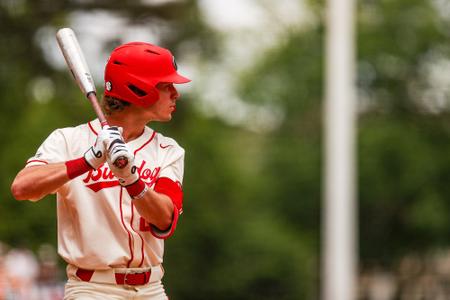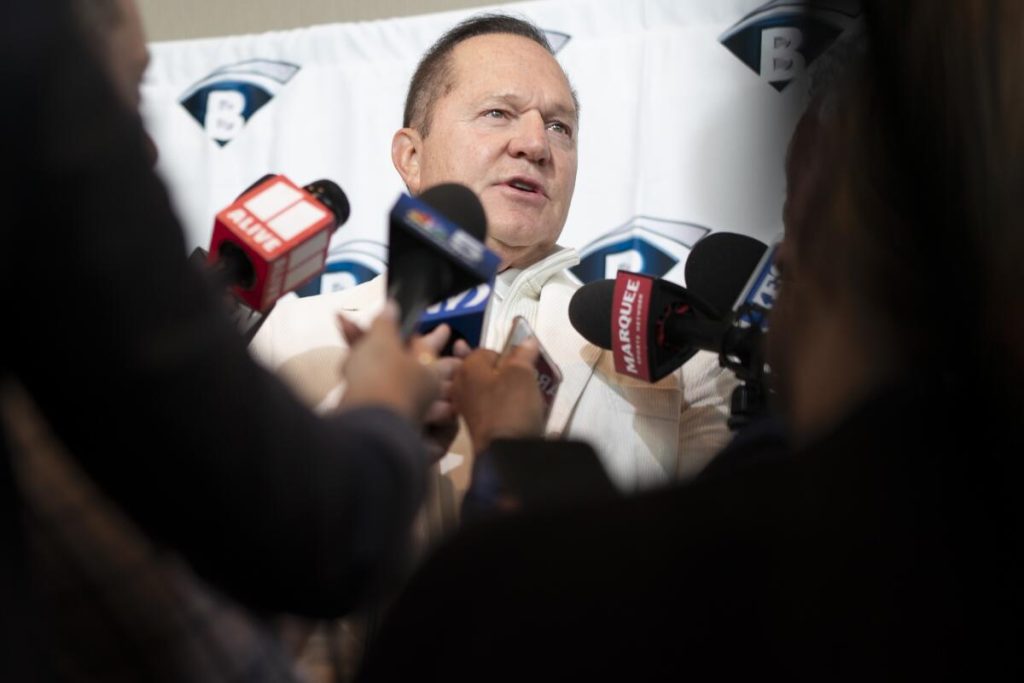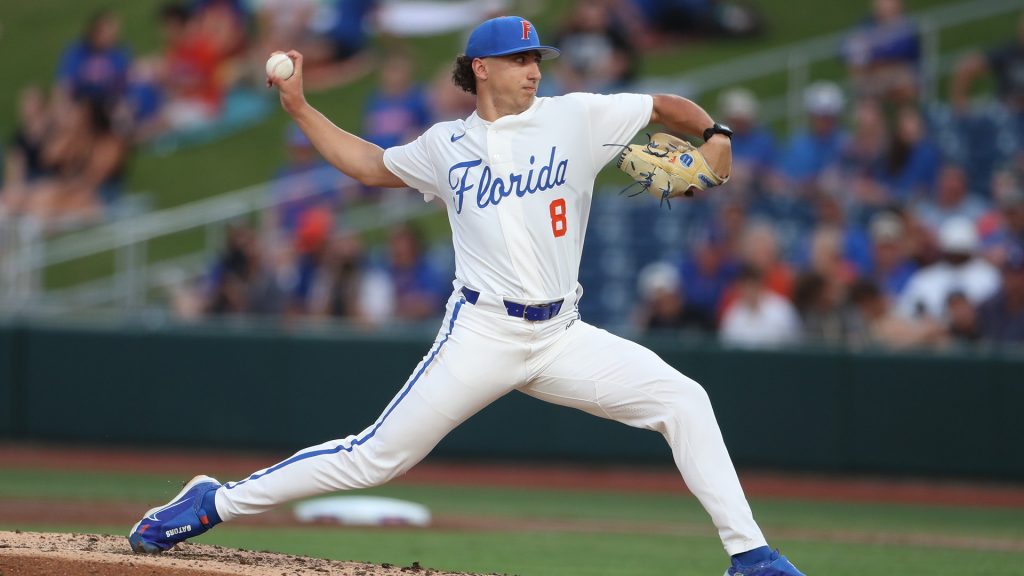Here’s a quick recap with some thoughts on day 3 of the 2024 MLB Draft, rounds 11-20
Reminder: Draft tracking Links
- MLB Draft Tracker: updated for first 10 slots with all the info for our draftees plus Twitter accounts.
- List of all Slot values for 2024
- The Nats Draft Tracker master XLS, which I’m building out for 2024 as we go. With the trade we just made, our bonus pool is 13,895,100, but with the 5% buffer we can go up to 14,589,855 on our first 10 picks and 11th-20th rounders who get more than $150k.
11th Round, 320 Overall: Merrett Beeker, a LHP starter Coll jr from Ball State.
11th rounders are generally where you’ll find interesting over-slot deals made, since there’s a flat $150k bonus structure for each player and there’s no “slot savings” for under-slot deals like there are for the back half of day 2. The Nats have signed a couple of above-slot 11th rounders in the past (Luke Young in 2022, JT Arruda in 2019 for example) and last year grabbed a Juco guy named Gavin Austin in the same gambit but couldn’t get him to sign (he was drafted in the 8th round this year by Pittsburgh).
That being said, this year we take Beeker, a LHP starter who was Ball State’s #2/Saturday starter this year and had some pretty intriguing numbers. He went 9-3 with a 4.11 ERA, 1.22 Whip, but he had 128 Ks in 81ip! that’s a 14 K/9 rate for a starter, which was good for #6 in the nation this year. The top 5 K/9 leaders ahead of him include 2 first rounders Hagen & Smith, plus 2nd rounder Brecht and 4th rounder Langevin, so that’s heady company. An interesting pick for sure, and not really one that looks like it needs an overslot deal.
12th round, 350 overall: Alexander Meckley, RHP college Junior starter/reliever from Coastal Carolina.
BA Ranked him #421 this year. Their scouting report: He was hit around a bit in his first 43 innings as a starter and reliever but has a big arm with a fastball that sits 93-94 and touches 97 with riding life from a high release point. Meckley has a four- and two-seam variation on his fastball and will spin a low-80s slider and upper-70s curveball with more depth.
This pick is interesting. Meckley started the year as CCU’s Friday night starter, and he started the year really well. He went 7ip and gave up 2hits in march against CWS team JMU. He held his own against early season opponents like Ball State, Indiana, and Michigan. Then suddenly he fell off a cliff, ending with a 2ip/8Run embarrassment against Wake Forest. At which point, CCU took him out of the rotation entirely. He ended the season with a 7.52 ERA and a 1.44 whip. He was a Juco transfer into Coastal, and in Juco his numbers were decent, so perhaps the team had a local area scout who remembered the guy. One has to think he’s relatively signable at the $150k slot here; if you get drafted the year after you put up an ERA in the 7s, you should probably take the money and give pro ball a try.
13th round, 380 overall: Bryant Olson, LHP reliever college junior from Mercer
Olson was Mercer’s closer for a while this season, finishing with 8 saves and some ugly stat lines. 6.41 ERA, 2.25 whip. 39/29 K/BB in 26 innings. Not much info out there on him, but a lefty with big K numbers could indicate a project the team is willing to work on.
14th round: 410 overall: Yoel Tejeda Jr. a draft-eligible Sophomore RHP from Florida State.
Tejeda is a massive (6’8″) guy, who transferred out of Florida and to Florida State for 2024. He got a couple of opener-starter gigs but was mostly in the bullpen for the FSU team. He got shelled in a game on May 26th against Duke, where he walked in a run and gave up a grand slam, and didn’t appear the rest of the season. The gamer from that game was blunt; calling his use an “experiment” that continued to go badly. His season numbers: 5.95 ERA in just 19ip, and more walks than strikeouts.
Why did he never pitch after May 26th? Injury? Or banishment to the bench? Either way, I wonder if he’s more likely to enter the transfer portal than he is to end his college career on this note. He turned down mid-teen money out of HS two years ago (he was drafted 18th round by Pittsburgh) and maybe he’ll do it again.
That makes four straight day-3 college arms. They’ve done so well in the past couple of drafts with this strategy (Sthele, Sullivan, Amaral last year, Lord and Luckham the year before, Alvarez in 2021…) that you can’t blame them for this strategy. Does anyone want to bet that one of these mid-teens college juniors won’t make a fast jump?
15th round: 440 overall: Sir Jamison Jones, a HS Catcher from St. Rita HS (IL)
BA ranked 372. Their report: Jones is one of the most physical players in the 2024 prep class and has tons of strength currently with a 6-foot-3, 225-pound frame. He can generate huge fly balls and has exciting power upside because of his massive strength, though he’ll need to refine his approach significantly and make more contact to fully tap into that raw power. His pitch recognition is inconsistent and he was also late against fastballs a bit too often. Jones has a big arm behind the plate, but he’ll need to work to stick behind the plate and might fit best as a first baseman. He’s a well below-average runner. Jones is committed to Oklahoma State.
I about spit out my drink when I saw this pick. A High School catcher in the 15th round? And, after doing the BA and PerfectGame research, apparently a good one. He’s been at all the showcase events, is one of the top ranked players coming out of Illinois, and he’s got a commitment to a big-time college in Oklahoma State.
Well, if you’re saving your pennies, this is where they could go. But a 6-3 225 guy screams 1B, not C, but he also seems like a project. Is he really signable here? He’s not a top 100 ranked guy, so we’re not talking millions to buy him out of Ok State, so I wonder what the angle here is.
16th round, 470 overall: Nolan Hughes, college senior LHP from Xavier
Hughes was played the first three years of his career at Fordham, then transferred to Xavier for 2024. He was mostly a bullpen guy, who got 4 starts on the year and faced some decent competition admirably. Season stats were mediocre until you see the K line. 4.33 ERA, 1.90 whip. 65/52 K/BB in 35ip. That is an astonishing 16.7 K/9 rate. He’s a big velocity lefty, can touch 98 with off-speed stuff that includes an 81mph sweeping curve and an 87mph changeup. That must look like an eephus pitch. Clean mechanics, looks solid in the little video snippets we can find. A project, but has some tools to work with.
17th round, 500 overall: Gavin Bruni, LHP starter from Ohio State
BA #384. Their scouting report: Bruni was an arm-strength lefthander who was already touching 96 mph in high school, but also had real control questions. Three years later and he’s still largely that sort of pitcher. A 6-foot-3, 205-pound starter, Bruni sits around 90 mph with his fastball and will run it up to 95-96 with above-average carry on the pitch but below-average command. He mixes in a slider around 80 and a curveball in the mid 70s that both have solid spin. He has a low-80s changeup that he rarely throws and isn’t likely to be a big piece of his arsenal moving forward without significant improvement. Bruni has been a full-time starter for Ohio State, but likely projects as a reliever in pro ball thanks to a career walk rate around 17%.
A weekend starter for Ohio State, which isn’t really that big of a baseball program. 6.19 ERA this season with not impressive peripherals. As the writeup says, he projects as a lefty reliever in pro ball, where he can sit more in the 95-96 range for an inning.
18th round: 530 overall. Teo Banks, OF (CF) college jr from Tulane.
Banks was Tulane’s CF and #2 hitter in the post-season; not sure if that’s where he played the whole season, but that’s where he ended it. Slash line for the year: .265/.380/.543 with some power and some speed. He’s a bigger dude, (6’2 205) so he might project as a corner in pro ball. I wish he had a better hit tool this year, but for what its worth he hit .301 as a sophomore and .317 as a freshman. He started part of freshman, all of sophomore and all of junior. He seems sign-able here.
19th round: 560 overall: Ryan Minckler, college junior RHP from Niagara University
Minckler served as kind of a long-man reliever for Niagara this year, 20 games, 50+ innings, with decent numbers. Initially went to UVA but never appeared, so he transferred and was in the Niagara rotation last year. Never seems to go more than 3-4 innings an appearance. Probably immediately projects to be a pro reliever.
His twitter has a pinned post from June 30th that says he’s transferring to Arizona State. He’s listed as a college junior but he redshirted his freshman year so technically he has two years of eligibility left, so me thinks he’s going to ASU and won’t sign. It’s not often you get to move to a major baseball program, in Arizona … which is about as far away a place from a college perspective as you can get from Niagara.
20th round: 590 overall: Colby Shelton, a SS/3B college junior from Florida
BA scouting report: Shelton had a standout freshman season with Alabama in 2023, when he led the club with 25 home runs en route to a second-team All-America selection. After the season, Shelton transferred to Florida, where he continued to show a powerful lefthanded bat. His production took a slight step backward in 2024, when he hit .256/.381/.573 with 20 home runs in 61 games. A 6-foot, 200-pound lefthanded hitter, Shelton is strong with all-fields power that comes with plenty of swing-and-miss. He sets up with a slightly crouched stance that includes a high handset and small leg lift, though he can be a bit rigid and stiff at times. His career strikeout rate sits in the 24-25% range, and he has contact questions versus all pitch types and an aggressive approach that leads to too many swings out of the zone. Because of Shelton’s back-to-back 20-homer seasons in the Southeastern Conference, some scouts think he will hit for enough impact to profile as a bat-first infielder. A shortstop now, Shelton profiles better at either third base or second base thanks to just OK actions and quickness. He can throw from multiple angles nicely and has enough arm strength for the left side of the infield. He is a fringe-average runner. He fits anywhere from round two to four.
So, this is the most interesting pick of the draft for this team. 20th rounder but MLB has him ranked #133 and BA has him all the way up at #64. Why did he fall? He was a 2nd team All American after the 2023 season, then left Alabama to go to Florida. He struggled this year: .254/.374/.551 but still hit 20 homers for one of the best teams in the land. In Florida’s final game, a loss to Texas A&M in Omaha, he played SS and batted cleanup. This is a big-time player. Can the team come with 3rd round money ($1M?) to sign him? Maybe; I can’t see an obvious massive over-slot guy anywhere else here, and I suspect they’re saving at least that amount off their 1st rounder.
We’ll do a draft class recap post later this week, summarizing.
